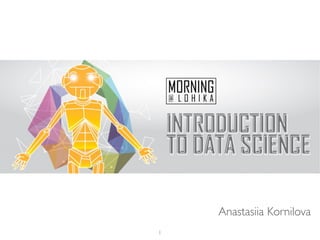Introduction to Data Science
- 2. WHO AM I? ŌĆó 3+ years in Data Science ŌĆó MS in Applied Mathematics ŌĆó Professional interests: recommendations systems, natural language processing, scalable data science solutions ŌĆó Authors of two blogs: energy’¼ürefox.blogspot.com, datascientistdiary.blogspot.com ŌĆó Fan of online education (20+ ’¼ünished MOOCs)
- 3. ŌĆó What is Data Science and why do we need it? ŌĆó Data Scientists.Who they are and what do they do? ŌĆó How to start? ŌĆó Practical case AGENDA 3
- 7. MAKING SENSE OF DATA
- 9. DATA ISTHE NEW OIL
- 10. WHAT IS DATA SCIENCE? Andrew Conway 10
- 11. FRAUD DETECTION
- 12. RECOMMENDATIONS
- 13. OPTIMISATION
- 17. FIND PATTERNS IS USER BEHAVIOUR/ACTIONS
- 18. WHO USES DATA SCIENCE? 18
- 20. WHO DATA SCIENTISTS ARE AND WHAT DOTHEY DO? 20
- 21. TYPES OF DATA SCIENTISTS A - Analysis B - Building Robert Chang
- 22. DSTYPE ŌĆ£AŌĆØ - ANALYSIS ŌĆó making sense of data or working with it in a fairly static way. ŌĆó very similar to a statistician (and may be one) ŌĆó knows all the practical details of working with data that arenŌĆÖt taught in the statistics curriculum: data cleaning, methods for dealing with very large data sets, visualization, deep knowledge of a particular domain, writing well about data
- 23. ŌĆó share some statistical background withType A ŌĆó very strong coders and may be trained software engineers ŌĆó mainly interested in using data ŌĆ£in production.ŌĆØ ŌĆó build models which interact with users, often serving recommendations (products, people you may know, ads, movies, search results). DSTYPE ŌĆ£BŌĆØ - BUILDING
- 24. WHAT DOTHEY DO?
- 25. Understand Collect Data exploration Clean and transform Model Validate Communicating results Deploy WHAT DOTHEY DO?
- 26. TYPICAL DATA SCIENCE WORKFLOW ŌĆó Preparing to run a model (Gathering, cleaning, transformation) ŌĆó Running the model ŌĆó Interpreting the results ŌĆ£80% of workŌĆØ - Aaron Kimball ŌĆ£Other 80% of the workŌĆØ 26
- 28. DOMAIN KNOWLEDGE AND SOFT SKILLS ŌĆó Passionate about the business ŌĆó Curios about data ŌĆó In’¼éuence without authority ŌĆó Hacker mindset ŌĆó Problem solver ŌĆó Strategic, proactive, creative, innovative and collaborative 28
- 29. MATH AND STATISTICS ŌĆó Machine learning ŌĆó Statistical modelling ŌĆó Experiment design ŌĆó Supervised learning ŌĆó Unsupervised learning ŌĆó Optimisation 29
- 30. PROGRAMMING AND DATABASES ŌĆó Computer science fundamentals ŌĆó Scripting language ŌĆó Statistical computing language ŌĆó Databases ŌĆó Relational algebra ŌĆó Distributed computations 30
- 31. COMMUNICATION AND VISUALIZATION ŌĆó Ability to engage with senior management ŌĆó Storytelling skills ŌĆó Visual art design ŌĆó Knowledge of a vizualisation tool ŌĆó Translate data-driven insights into decisions and actions 31
- 33. HARD WAY 33
- 34. TRADITIONAL WAY ŌĆó LITS - Machine Learning ŌĆó UCU - CS Master Degree ŌĆó Data Science Degree ŌĆó Kyivstar - Big Data University 34
- 35. EASY WAY 35
- 38. AND NOW WHAT? 38
- 41. AREYOU GOOD ENOUGH? AREYOU GOOD ENOUGH?41
- 42. KAGGLE STORY 42
- 44. WHAT CAN YOU FIND ON KAGGLE? ŌĆó Knowledge ŌĆó Money ŌĆó Job ŌĆó Reputation 44
- 45. 1. Understand 2. Collect 3. Data exploration 4. Clean and transform 5. Model 6. Validate 7. Communicating results Deploy 45
- 47. TIME FOR FUN San Francisco crimes analysis
- 48. THANK YOU!
- 49. LINKS ŌĆó https://medium.com/@rchang/my-two-year-journey-as-a-data-scientist-at-twitter-f0c13298aee6#.49jdojamn ŌĆó https://blog.kissmetrics.com/how-net’¼éix-uses-analytics/ ŌĆó http://recode.net/2015/10/07/jawbone-isnt-a-hardware-company-anymore-says-ceo-hosain-rahman/ ŌĆó https://jawbone.com/blog/napa-earthquake-effect-on-sleep/ ŌĆó http://cs.ucu.edu.ua/ ŌĆó http://lits.com.ua/course/machine-learning/ ŌĆó http://bigdata.kyivstar.ua/ ŌĆó https://www.kaggle.com/ ŌĆó http://inversquare.github.io/moon/mooncrime.html#part-2-crimes-of-passion ŌĆó http://journals.plos.org/plosone/article?id=10.1371/journal.pone.0059030#abstract0 ŌĆó http://blog.babajob.com/wp-content/uploads/2015/08/manyhands-300x161.jpg ŌĆó http://www.criminalelement.com/images/stories/-2015-Jul-Sep/sherlock-holmes-benedict-cumberbatch.jpg

















































